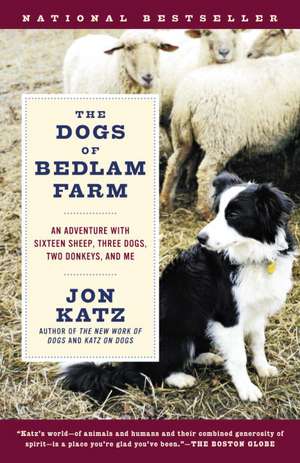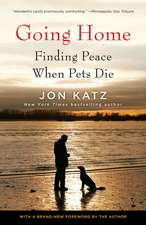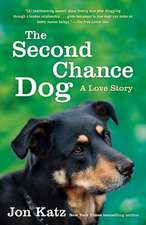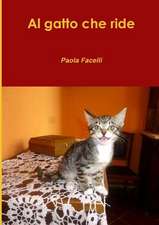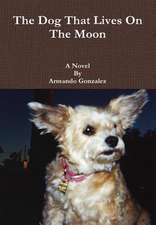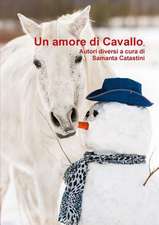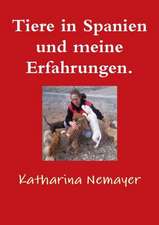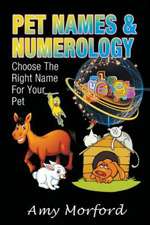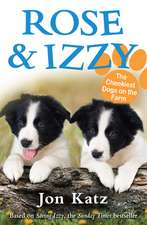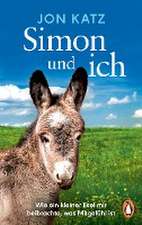The Dogs of Bedlam Farm: An Adventure with Sixteen Sheep, Three Dogs, Two Donkeys, and Me
Autor Jon Katzen Limba Engleză Paperback – 31 aug 2005
–from The Dogs of Bedlam Farm
When Jon Katz adopted a border collie named Orson, his whole world changed. Gone were the two yellow Labs he wrote about in A Dog Year, as was the mountaintop cabin they loved. Katz moved into an old farmhouse on forty-two acres of pasture and woods with a menagerie: a ram named Nesbitt, fifteen ewes, a lonely donkey named Carol, a baby donkey named Fanny, and three border collies.
Training Orson was a demanding project. But a perceptive dog trainer and friend told Katz: “If you want to have a better dog, you will just have to be a better goddamned human.” It was a lesson Katz took to heart. He now sees his dogs as a reflection of his willingness to improve, as well as a critical reminder of his shortcomings. Katz shows us that dogs are often what we make them: They may have their own traits and personalities, but in the end, they are mirrors of our own lives–living, breathing testaments to our strengths and frustrations, our families and our pasts.
The Dogs of Bedlam Farm recounts a harrowing winter Katz spent on a remote, windswept hillside in upstate New York with a few life-saving friends, ugly ghosts from the past, and more livestock than any novice should attempt to manage. Heartwarming, and full of drama, insight, and hard-won wisdom, it is the story of his several dogs forced Katz to confront his sense of humanity, and how he learned the places a dog could lead him and the ways a doge could change him.
From the Hardcover edition.
Preț: 165.69 lei
Nou
Puncte Express: 249
Preț estimativ în valută:
31.71€ • 34.46$ • 26.66£
31.71€ • 34.46$ • 26.66£
Carte tipărită la comandă
Livrare economică 17-23 aprilie
Preluare comenzi: 021 569.72.76
Specificații
ISBN-13: 9780812972504
ISBN-10: 0812972503
Pagini: 265
Ilustrații: 1 ILLUSTRATION
Dimensiuni: 134 x 203 x 17 mm
Greutate: 0.2 kg
Ediția:Rh Trade Pbk.
Editura: Random House Trade
ISBN-10: 0812972503
Pagini: 265
Ilustrații: 1 ILLUSTRATION
Dimensiuni: 134 x 203 x 17 mm
Greutate: 0.2 kg
Ediția:Rh Trade Pbk.
Editura: Random House Trade
Notă biografică
JON KATZ has written thirteen books-–six novels and seven works of nonfiction, including A Dog Year and The New Work of Dogs. A two-time finalist for the National Magazine Award, he has written for The New York Times, the Wall Street Journal, Rolling Stone, and the AKC Gazette. A member of the Association of Pet Dog Trainers, he writes a column about dogs for the online magazine Slate and is co-host of “Dog Talk,” a monthly show on Northeast Public Radio. Katz lives on Bedlam Farm in upstate New York and in northern New Jersey, with his wife Paula Span, a Washington Post contributing writer and teacher at Columbia University, and their dogs. He can be e-mailed at jonkatz3@comcast.net or at jdkat3@aol.com.
From the Hardcover edition.
From the Hardcover edition.
Extras
Chapter One
CITY OF GOD
BEDLAM: a place, scene, or state of uproar and confusion
-Columbia Encyclopedia
Far in the distance, as the morning mists began to clear, I could see a livestock trailer heading west on Route 30 from Salem toward the hamlet of West Hebron. From this hill behind my new house, I could spot visitors approaching from miles away.
There were plenty of farms around this quadrant of upstate New York, lots of places livestock haulers might be going, but my guess was that this was Wilbur Price of Bethel, Pennsylvania, delivering a ram named Nesbitt and the ladies, fifteen “dog-broke” ewes.
Which meant it was time to walk down the hill. Change was just around the corner, big change.
For three border collies, there could be no more meaningful event than the arrival of sheep in their backyard. For me, the change was more complex, but a big transition nonetheless, another midlife crapshoot. I was stepping out of one existence and into another, a shift inexorably linked to these three dogs.
We all clambered down the hill as the trailer descended into town. In a few minutes, this farm, known around the county as the old Keyes place—somehow I doubted it would ever be known as the old Katz place—with its listing and peeling dairy barn, an even more askew pig barn, an overgrown chicken pen, and several other outbuildings, would be home once again to livestock. Everyone in the tiny village could look up the hill and see animals grazing, as they had for generations.
I was no farmer, and this place wouldn’t really qualify as a working farm. I am a dog lover and writer, and this would be, in part, a dog-centric adventure with my border collies. Even before the animals arrived, in the few weeks since I’d moved in and begun preparations, I could hardly believe the amount of work involved just in overseeing forty-two acres and a Civil War–era farmhouse. I could only imagine how difficult and relentless real farmwork was, particularly in brutal winter. My work would be fractional in comparison, and I wouldn’t rely on the farm to provide my family’s livelihood—an enormous difference.
Wilbur, a garrulous man in a giant baseball cap and overalls, was indeed waiting at the gravel driveway with his noisy cargo. We shook hands and chatted about the weather and the drive and his dicey encounters with fog en route. Wilbur, I realized, drove sheep and cows around all day and didn’t want to pass up the chance for a more satisfying conversation.
I, on the other hand, was eager to populate my farm and get it rolling. After considerable effort and dismaying expense, I had fences up, hay and straw in the barn, and corn and feed stashed in critter-proof containers all over. I was as ready as somebody like me was ever going to be. But I’d learned that country talk can’t be rushed. It had to have been a long and lonely ride up from Raspberry Ridge, my friend Carolyn’s sheep farm and dog-training center. These ewes were loaners from her much larger flock.
We knew these sheep. My elder dogs and I, frequent visitors and herding students at Raspberry Ridge, had taken them to graze in the pasture countless times in rain and sunshine, in deep night and bright day, heat and cold. We’d moved them around during herding trials, chased them during our lessons, retrieved them from the woods when they wandered, midwifed a few of their lambs. We also knew—and were appropriately wary of—Nesbitt, who’d sent me flying more than once.
I could hear them all shifting and bleating in the trailer, probably hungry and thirsty. I heard an asthmatic-sounding bray, too, which meant that at the last minute Carolyn had decided to send the donkey along with the rest of the crew. The donkey lived alone in a pasture, and Carolyn thought she might have a better quality of life at my new encampment. Carol, the donkey, was a sweetheart, whose affections I’d won with gifts of apples; I wondered if she’d recognize me in this strange new environment.
Wilbur finally sensed that it was time to get moving. He slowly backed the truck a few feet inside the barnyard gate and slipped the latches that opened his trailer.
Carol the Lonely Donkey hee-hawed again, looked around, snarfed down the donkey cookie I was holding out for her, and trotted down the ramp. She did seem to remember me, and in any case appreciated the cookie.
Behind her, fifteen sheep and Nesbitt came charging past me, headed for the lush grass that covered the hill, and immediately started crunching away. Unlike dogs, sheep are not complex in their attachments. Grass is good. Grass is always good.
I shook Wilbur’s hand and wrote out a check on the cab of his truck. Bedlam Farm was in business.
My dogs, corralled in their own spacious fenced enclosure a few yards away, sat frozen; they seemed shocked, wide-eyed, ears and tails at the alert. One rarely sees a more focused look on any creature than I saw on the faces of Orson, Homer, and Rose.
The autumn wind was sharp, parting the mists on the hill. I looked up to see a small flock of sheep and a donkey grazing near an old apple tree. I could hardly believe it myself; they looked as if they had grown out of the ground and had been there forever. Wilbur declined coffee and other amenities, saying he wanted to be home for dinner, and after much rattling, banging, and slamming, the truck rumbled off down the dirt road into town, back to the world.
It was one thing to drive out and work with Carolyn’s sheep once or twice a week from suburban New Jersey, where much of the time my dogs and I lived an ordinary-looking life with my wife. It was quite another to be responsible for sheep living just outside my kitchen window.
They would need shots and worming and medical certificates from a vet. They would need to be shorn, to have their hooves trimmed. They’d need corn to build up calories for the winter, vitamin supplements when the ewes got pregnant, straw to lie on, and hay to eat once the grass withered in the first hard frost. They needed a continuous supply of fresh water, even in sub-zero weather.
In a few months, their newborn lambs would need to be located instantly, dried, and placed under heating lamps, separate from the rest of the flock. Lambs often required special supplements, and they’d need to be tagged and registered and have their tails docked. And everyone would need shelter from the vicious winter storms that would be arriving in just a few weeks.
All of these things had to be provided when the ice was packed a foot deep on the ground amid waist-high mounds of snow. And I had to—wanted to—take care of almost all those things myself.
When we bought this place, my wife, Paula, had set down three ironclad conditions: no firearms; no farm or other heavy machinery; and the gargantuan 1982 Chevy Silverado pickup I’d bought for hauling hay and other farm chores was not to be driven more than five miles in any direction. She was convinced that it would break down at inconvenient times; I had to be able to walk home.
Anybody who knew me understood the wisdom of these conditions. So while I would need help with barn repairs, drainage ditches, anything involving heavy machinery, the work was otherwise mine to do.
So as Wilbur drove out of sight and I waved goodbye, I was elated but also unnerved. There was no going back.
Our day had begun much earlier, around five a.m., with our new morning routine. Orson, Homer, and the puppy, Rose, had labored up the steep hill behind the house with me, the wind whipping around us, tearing leaves off the trees at the top of the ridge. Even in the forbidding predawn, I could scarcely believe I owned such a beautiful tract of countryside. I could hear the occasional yip-yip of coyotes—“coy dogs,” the locals call them—and wondered how soon they would be circling my soon-to-
arrive sheep.
To be honest, I was the only one laboring up the hill, heading for two Adirondack chairs placed at the crest. The dogs were racing and gliding effortlessly, zipping around in enthusiastic circles the way border collies go everywhere—back and forth, round and round, always somehow keeping me in the center. I’d become used to walking in this odd way, aware vaguely that I was being herded. The two adults, Orson and Homer, had plenty of energy, but Rose positively zoomed, galloping from one corner of the pasture to the other in the time it took me to go a few steps.
Every dog has a story, but Orson’s is better known than some. A breeder in Texas had retrieved him from someone she deemed an unsuitable owner, then sent him to me after reading one of my books, in which I talked about my late, beloved yellow Labs. Orson, then named Devon, was a dog in trouble. He was anxious, confused, apt to jump onto passing minivans, herd school buses, raid the refrigerator and jump through windows; we brawled until I found a great trainer—Carolyn—who helped turn our lives around.
He was followed by Homer, as sweet and submissive as Orson was difficult, but a dog who presented challenges of his own. Then a few months ago, our pack had been joined by Rose, the nuclear-powered puppy with strong herding lines who made the other two seem like stone statues. People ask me why I got a third border collie, and the truth is I hardly know. I still can’t quite explain why I got the first one.
“Guys, this will be a great day for you,” I announced. “Soon there will be fifteen ewes in this field, along with a grumpy ram named Nesbitt and maybe a donkey. You’ve got to watch out for Nesbitt. He’ll nail me.”
It had only been a couple of months since I had put my cherished mountaintop retreat—a cabin where I’d written three books and found more peace and beauty than I’d ever known—up for sale. I wanted to buy an old farmhouse with a porch, some land, maybe a barn. Through a series of flukes, I’d gotten more than I’d bargained for, more acreage, a lovelier house, more barns in more advanced stages of decay, along with coyotes, hawks and songbirds, yellow jackets and fleas, feral cats, rats and mice (despite the feral cats), raccoons, chipmunks, foxes, loads of deer, and unconfirmed rumors of two moose and a mountain lion. I also had a sweeping view of a lush valley checkered with pastures, cornfields, and barns.
The classic white Greek revival farmhouse had seen a lot of history. It sat on a hillside above a tiny hamlet of thirty or forty houses, two lovely old churches, and a general store—Bedlam’s Corner. The name mesmerized me from the moment I first drove by.
My earlier cabin, a half hour south of Hebron, was a getaway, a private corner for a writer’s internal life. I worked there, read, hiked with the dogs. Apart from my wife and daughter and two or three friends, hardly anyone else had ever seen it. That was part of the problem; it was my place and only my place.
As much as I’d loved it, as important as it had become, the cabin had also defeated me in a way. It was so small that there was barely enough space for the dogs and me; it felt crowded when my wife visited, let alone my daughter Emma. I had come to want not a retreat for me, but a rural home for us, with places for Paula to work and Emma to stay, with space for friends—a place for liveliness more than solitary contemplation. I felt ready for a fuller existence, though I had no inkling just how full it was about to get.
I was conscious, as I try always to be, of entering another phase, of marking the transition and pondering how I was going to deal with it. I’d just turned fifty-six. How many more houses would I be buying? How many more dogs could I ever own? How much more time did Paula and I have to be together in a place like this?
I couldn’t really afford the farm any more than I could the cabin that preceded it, but I couldn’t really afford to wait, either. For several years, especially since the terrorist attacks on New York City, I’d seen people assessing their lives, making changes, seeking property upstate. In another five years I doubted I’d be able to buy acreage. My little cabin, forlorn and ungainly at the time, had been on the market for two years when I bought it. It sold in less than a week, once I put it on the market.
Driving me around the town of Hebron as I looked for the replacement I had in mind, the real estate agent had looked up at the hillside as we passed and pointed at the white farmhouse. “There’s the house you want,” she said ruefully. “But it isn’t for sale.” Three weeks later, it suddenly was. Sometimes houses, like dogs, find you.
What better place to test my notions about dogs and humans than here, with border collies and a bunch of sheep? Could they become happier dogs and more useful partners? Could I learn to be a better human? The four of us and our little band of animals, tucked away on a hillside through a glorious fall, the bitter upstate winter, and a cold, muddy spring filled with lambing, could probably find out.
Two months later, I was here, unpacking boxes and dealing with hay supplies, cranky barn doors, monosyllabic Vermont fence builders, and more. It seemed I had compressed years of activities into weeks and days—selling a beloved home, buying a more complex one, moving out and in, arranging the endless details that would make it possible for me and my assorted livestock to live here.
In a few hours, I told the dogs, as we puffed uphill in the dark, there would be sheep right out the back door. The announcement wasn’t as loopy as it seemed: every mention of the word “sheep” got three heads swiveling. Even little Rose, who’d visited Raspberry Ridge just a few times, was already hooked and showing quite a bit of herding style.
I bought the place for my family and me, but my wife pointed out what I privately conceded—I bought it for the dogs, as well. Owning land you could barely see the end of was wonderful, but owning property that could give dogs a chance to do and perfect what they most loved, what their breed had done for hundreds of years, that was still another dimension.
From the Hardcover edition.
CITY OF GOD
BEDLAM: a place, scene, or state of uproar and confusion
-Columbia Encyclopedia
Far in the distance, as the morning mists began to clear, I could see a livestock trailer heading west on Route 30 from Salem toward the hamlet of West Hebron. From this hill behind my new house, I could spot visitors approaching from miles away.
There were plenty of farms around this quadrant of upstate New York, lots of places livestock haulers might be going, but my guess was that this was Wilbur Price of Bethel, Pennsylvania, delivering a ram named Nesbitt and the ladies, fifteen “dog-broke” ewes.
Which meant it was time to walk down the hill. Change was just around the corner, big change.
For three border collies, there could be no more meaningful event than the arrival of sheep in their backyard. For me, the change was more complex, but a big transition nonetheless, another midlife crapshoot. I was stepping out of one existence and into another, a shift inexorably linked to these three dogs.
We all clambered down the hill as the trailer descended into town. In a few minutes, this farm, known around the county as the old Keyes place—somehow I doubted it would ever be known as the old Katz place—with its listing and peeling dairy barn, an even more askew pig barn, an overgrown chicken pen, and several other outbuildings, would be home once again to livestock. Everyone in the tiny village could look up the hill and see animals grazing, as they had for generations.
I was no farmer, and this place wouldn’t really qualify as a working farm. I am a dog lover and writer, and this would be, in part, a dog-centric adventure with my border collies. Even before the animals arrived, in the few weeks since I’d moved in and begun preparations, I could hardly believe the amount of work involved just in overseeing forty-two acres and a Civil War–era farmhouse. I could only imagine how difficult and relentless real farmwork was, particularly in brutal winter. My work would be fractional in comparison, and I wouldn’t rely on the farm to provide my family’s livelihood—an enormous difference.
Wilbur, a garrulous man in a giant baseball cap and overalls, was indeed waiting at the gravel driveway with his noisy cargo. We shook hands and chatted about the weather and the drive and his dicey encounters with fog en route. Wilbur, I realized, drove sheep and cows around all day and didn’t want to pass up the chance for a more satisfying conversation.
I, on the other hand, was eager to populate my farm and get it rolling. After considerable effort and dismaying expense, I had fences up, hay and straw in the barn, and corn and feed stashed in critter-proof containers all over. I was as ready as somebody like me was ever going to be. But I’d learned that country talk can’t be rushed. It had to have been a long and lonely ride up from Raspberry Ridge, my friend Carolyn’s sheep farm and dog-training center. These ewes were loaners from her much larger flock.
We knew these sheep. My elder dogs and I, frequent visitors and herding students at Raspberry Ridge, had taken them to graze in the pasture countless times in rain and sunshine, in deep night and bright day, heat and cold. We’d moved them around during herding trials, chased them during our lessons, retrieved them from the woods when they wandered, midwifed a few of their lambs. We also knew—and were appropriately wary of—Nesbitt, who’d sent me flying more than once.
I could hear them all shifting and bleating in the trailer, probably hungry and thirsty. I heard an asthmatic-sounding bray, too, which meant that at the last minute Carolyn had decided to send the donkey along with the rest of the crew. The donkey lived alone in a pasture, and Carolyn thought she might have a better quality of life at my new encampment. Carol, the donkey, was a sweetheart, whose affections I’d won with gifts of apples; I wondered if she’d recognize me in this strange new environment.
Wilbur finally sensed that it was time to get moving. He slowly backed the truck a few feet inside the barnyard gate and slipped the latches that opened his trailer.
Carol the Lonely Donkey hee-hawed again, looked around, snarfed down the donkey cookie I was holding out for her, and trotted down the ramp. She did seem to remember me, and in any case appreciated the cookie.
Behind her, fifteen sheep and Nesbitt came charging past me, headed for the lush grass that covered the hill, and immediately started crunching away. Unlike dogs, sheep are not complex in their attachments. Grass is good. Grass is always good.
I shook Wilbur’s hand and wrote out a check on the cab of his truck. Bedlam Farm was in business.
My dogs, corralled in their own spacious fenced enclosure a few yards away, sat frozen; they seemed shocked, wide-eyed, ears and tails at the alert. One rarely sees a more focused look on any creature than I saw on the faces of Orson, Homer, and Rose.
The autumn wind was sharp, parting the mists on the hill. I looked up to see a small flock of sheep and a donkey grazing near an old apple tree. I could hardly believe it myself; they looked as if they had grown out of the ground and had been there forever. Wilbur declined coffee and other amenities, saying he wanted to be home for dinner, and after much rattling, banging, and slamming, the truck rumbled off down the dirt road into town, back to the world.
It was one thing to drive out and work with Carolyn’s sheep once or twice a week from suburban New Jersey, where much of the time my dogs and I lived an ordinary-looking life with my wife. It was quite another to be responsible for sheep living just outside my kitchen window.
They would need shots and worming and medical certificates from a vet. They would need to be shorn, to have their hooves trimmed. They’d need corn to build up calories for the winter, vitamin supplements when the ewes got pregnant, straw to lie on, and hay to eat once the grass withered in the first hard frost. They needed a continuous supply of fresh water, even in sub-zero weather.
In a few months, their newborn lambs would need to be located instantly, dried, and placed under heating lamps, separate from the rest of the flock. Lambs often required special supplements, and they’d need to be tagged and registered and have their tails docked. And everyone would need shelter from the vicious winter storms that would be arriving in just a few weeks.
All of these things had to be provided when the ice was packed a foot deep on the ground amid waist-high mounds of snow. And I had to—wanted to—take care of almost all those things myself.
When we bought this place, my wife, Paula, had set down three ironclad conditions: no firearms; no farm or other heavy machinery; and the gargantuan 1982 Chevy Silverado pickup I’d bought for hauling hay and other farm chores was not to be driven more than five miles in any direction. She was convinced that it would break down at inconvenient times; I had to be able to walk home.
Anybody who knew me understood the wisdom of these conditions. So while I would need help with barn repairs, drainage ditches, anything involving heavy machinery, the work was otherwise mine to do.
So as Wilbur drove out of sight and I waved goodbye, I was elated but also unnerved. There was no going back.
Our day had begun much earlier, around five a.m., with our new morning routine. Orson, Homer, and the puppy, Rose, had labored up the steep hill behind the house with me, the wind whipping around us, tearing leaves off the trees at the top of the ridge. Even in the forbidding predawn, I could scarcely believe I owned such a beautiful tract of countryside. I could hear the occasional yip-yip of coyotes—“coy dogs,” the locals call them—and wondered how soon they would be circling my soon-to-
arrive sheep.
To be honest, I was the only one laboring up the hill, heading for two Adirondack chairs placed at the crest. The dogs were racing and gliding effortlessly, zipping around in enthusiastic circles the way border collies go everywhere—back and forth, round and round, always somehow keeping me in the center. I’d become used to walking in this odd way, aware vaguely that I was being herded. The two adults, Orson and Homer, had plenty of energy, but Rose positively zoomed, galloping from one corner of the pasture to the other in the time it took me to go a few steps.
Every dog has a story, but Orson’s is better known than some. A breeder in Texas had retrieved him from someone she deemed an unsuitable owner, then sent him to me after reading one of my books, in which I talked about my late, beloved yellow Labs. Orson, then named Devon, was a dog in trouble. He was anxious, confused, apt to jump onto passing minivans, herd school buses, raid the refrigerator and jump through windows; we brawled until I found a great trainer—Carolyn—who helped turn our lives around.
He was followed by Homer, as sweet and submissive as Orson was difficult, but a dog who presented challenges of his own. Then a few months ago, our pack had been joined by Rose, the nuclear-powered puppy with strong herding lines who made the other two seem like stone statues. People ask me why I got a third border collie, and the truth is I hardly know. I still can’t quite explain why I got the first one.
“Guys, this will be a great day for you,” I announced. “Soon there will be fifteen ewes in this field, along with a grumpy ram named Nesbitt and maybe a donkey. You’ve got to watch out for Nesbitt. He’ll nail me.”
It had only been a couple of months since I had put my cherished mountaintop retreat—a cabin where I’d written three books and found more peace and beauty than I’d ever known—up for sale. I wanted to buy an old farmhouse with a porch, some land, maybe a barn. Through a series of flukes, I’d gotten more than I’d bargained for, more acreage, a lovelier house, more barns in more advanced stages of decay, along with coyotes, hawks and songbirds, yellow jackets and fleas, feral cats, rats and mice (despite the feral cats), raccoons, chipmunks, foxes, loads of deer, and unconfirmed rumors of two moose and a mountain lion. I also had a sweeping view of a lush valley checkered with pastures, cornfields, and barns.
The classic white Greek revival farmhouse had seen a lot of history. It sat on a hillside above a tiny hamlet of thirty or forty houses, two lovely old churches, and a general store—Bedlam’s Corner. The name mesmerized me from the moment I first drove by.
My earlier cabin, a half hour south of Hebron, was a getaway, a private corner for a writer’s internal life. I worked there, read, hiked with the dogs. Apart from my wife and daughter and two or three friends, hardly anyone else had ever seen it. That was part of the problem; it was my place and only my place.
As much as I’d loved it, as important as it had become, the cabin had also defeated me in a way. It was so small that there was barely enough space for the dogs and me; it felt crowded when my wife visited, let alone my daughter Emma. I had come to want not a retreat for me, but a rural home for us, with places for Paula to work and Emma to stay, with space for friends—a place for liveliness more than solitary contemplation. I felt ready for a fuller existence, though I had no inkling just how full it was about to get.
I was conscious, as I try always to be, of entering another phase, of marking the transition and pondering how I was going to deal with it. I’d just turned fifty-six. How many more houses would I be buying? How many more dogs could I ever own? How much more time did Paula and I have to be together in a place like this?
I couldn’t really afford the farm any more than I could the cabin that preceded it, but I couldn’t really afford to wait, either. For several years, especially since the terrorist attacks on New York City, I’d seen people assessing their lives, making changes, seeking property upstate. In another five years I doubted I’d be able to buy acreage. My little cabin, forlorn and ungainly at the time, had been on the market for two years when I bought it. It sold in less than a week, once I put it on the market.
Driving me around the town of Hebron as I looked for the replacement I had in mind, the real estate agent had looked up at the hillside as we passed and pointed at the white farmhouse. “There’s the house you want,” she said ruefully. “But it isn’t for sale.” Three weeks later, it suddenly was. Sometimes houses, like dogs, find you.
What better place to test my notions about dogs and humans than here, with border collies and a bunch of sheep? Could they become happier dogs and more useful partners? Could I learn to be a better human? The four of us and our little band of animals, tucked away on a hillside through a glorious fall, the bitter upstate winter, and a cold, muddy spring filled with lambing, could probably find out.
Two months later, I was here, unpacking boxes and dealing with hay supplies, cranky barn doors, monosyllabic Vermont fence builders, and more. It seemed I had compressed years of activities into weeks and days—selling a beloved home, buying a more complex one, moving out and in, arranging the endless details that would make it possible for me and my assorted livestock to live here.
In a few hours, I told the dogs, as we puffed uphill in the dark, there would be sheep right out the back door. The announcement wasn’t as loopy as it seemed: every mention of the word “sheep” got three heads swiveling. Even little Rose, who’d visited Raspberry Ridge just a few times, was already hooked and showing quite a bit of herding style.
I bought the place for my family and me, but my wife pointed out what I privately conceded—I bought it for the dogs, as well. Owning land you could barely see the end of was wonderful, but owning property that could give dogs a chance to do and perfect what they most loved, what their breed had done for hundreds of years, that was still another dimension.
From the Hardcover edition.
Descriere
In this narrative, the author recounts a harrowing winter spent on a remote, windswept hillside in upstate New York with a few lifesaving friends, ugly ghosts from the past, and more livestock than any novice should attempt to manage.
